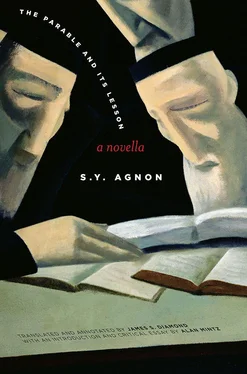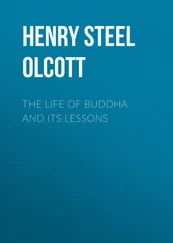Rather than being a genuine confession of limitation, the fuzziness about the exact name and the exact place serves as a gesture of humility whose purpose is to make the opposite point. Despite the fact that the strange adventure that is about to be described in great detail took place well beyond ten generations ago, these few facts at the beginning of the story are the only ones to which any doubt attaches. And the very fact that these details are wrangled over with other, unnamed minds works only to strengthen the status of the events described in the story as indisputably part of the collective historical record.
Agnon is playing here at something very deep yet elusive. There is of course no rational world in which a narrator can possess such infinite knowledge. Yet as readers we are prepared to recognize omniscience as a legitimate convention when it comes to modern fiction. Not only do we not question Flaubert’s right to represent Emma Bovary’s innermost thoughts but we applaud his comprehensive penetration into her mind. And although Flaubert — a favorite of Agnon’s — would claim his revelations of Emma’s inner life to be true, he would also acknowledge them, proudly, as fiction. This is not the case with Agnon in ‘Ir umelo’ah . The texts of this collection are presented as stories, as sipurim , narratives that occupy a middle ground between chronicle and fiction; sipur is a supremely serviceable term for Agnon because it as much at home in the world of Hasidic piety as it is in the world of Kleist and Kafka. Yet his was not the short story perfected and aestheticized by Chekhov, Maupassant and Joyce but rather the kind of tale told by a storyteller in a world before the institutionalization of literature. In the case of ‘Ir umelo’ah the storyteller is not a primitive spinner of legends or folktales but a sophisticated and opinionated narrator-chronicler who curates and recirculates accounts of the key moments in the town’s history and vouches for their accuracy. The pseudo-traditionalism of this form provided Agnon with a creative, flexible instrument. Although the narrator’s values are aligned with the pious norms at the core of the stories, his responsibilities as a chronicler entail his reliable reporting of the full range of human behavior; and thus a gap is opened up that is at turns playful, ironic and subversive. In subtle and surreptitious ways, Agnon could appropriate the authenticity and authority of the traditional tale without renouncing the toolkit of modernism. Agnon thus wants — and gets — to have his literary cake and eat it too. He wants the freedom to imagine conversations, inner thoughts and the intimate particulars of behavior; and at the same time he denies that his stories are made up or lack the status of responsible accounts of historical occurrences. Agnon appropriates for himself a conception of storytelling that avoids the necessity of facing this either-or.
The path that Agnon fashioned in ‘Ir umelo’ah was a watershed in the master’s relationship to the world he left behind as a youth. Setting aside for the moment the corpus of short stories, we note that Agnon wrote three novels between the world wars in which he attempted fictional reckonings with the exilic past. Hakhnasat kalah [The Bridal Canopy, 1931] is set in Galicia in the years before the Napoleonic wars and follows the wanderings of a holy fool who travels from town to town to raise money for his daughter’s dowry. Although told by a pious narrator, the novel is rife with parody and social critique, and its plot is driven by conventions of the melodramatic novel; the hero’s wanderings are used as an armature for an agglomeration of tales told at every station of his quest. Sipur pashut [A Simple Story, 1936], which takes place in Buczacz itself at the turn of the twentieth century, appropriates the conventions of the bourgeois family saga in the manner of Mann’s Buddenbrooks , in telling the story of a young man in conflict between romantic love and the mercantile ethos of his family. In this recension of Buczacz, religion has been reduced to cultural patterning in the background, and the town is presented as a site of incipient class conflict. The narrator of Oreaḥ natah lalun [A Guest for the Night, 1939] bears a close resemblance to Agnon himself; he is a Jew from Palestine who has returned for a yearlong visit to Shibush (Buczacz), the town of his youth, in the years after it was decimated by World War One and the anti-Jewish violence that accompanied it. He finds a nightmarish landscape full of amputated limbs and the ghosts of the town’s once-vibrant religious life; on the eve of his return to Palestine he is force to admit that his efforts to rekindle a spark of spirituality have come to nothing.
Each of these is a recognizably different modality of dealing with the ancestral world, entailing a particular kind of narrative framework. Without delving into their complex motives and strategies, it is enough to point out that in the last two decades of Agnon’s life none of them any longer served his purposes. The finality of the destruction of Buczacz in the Holocaust changed the status of the town as an imaginative object and required a new approach. Moreover, Agnon’s awareness of his own mortality and of the valedictory nature of the opportunity that lay before him lent urgency to the search for a large project that would stand as a final statement of his relationship to Buczacz and what it represented. That project would have to be novellike in its epic ambitions yet remain loyal to the traditional flexibility embodied in the story as an unapologetic vehicle whose value inheres in itself. The result of that search was ‘Ir umelo’ah .
HAMASHAL VEHANIMSHAL
[ THE PARABLE AND ITS LESSON ]
The story Hamashal vehanimshal is an excellent example of the tensions that generate Agnon’s best work in ‘Ir umelo’ah . 13The story takes place within two time frames. The present time of the story is set around the year 1710 and concerns an elderly shamash, a synagogue sexton, who is put on trial for an act of public humiliation. The tale he tells in his defense, which takes up three quarters of the whole story, is set a half century earlier during the years in which Galician Jewry was recovering from the massacres of 1648. That tale relates how he and Rabbi Moshe, the rabbi of Buczacz, undertake a descent into Gehinnom in order to ascertain the death of a young husband who has abandoned an even younger bride. While in the Netherworld, the shamash discovers a gruesome sight that subverts all his received notions about postmortem rewards and punishments. He sees great Talmud scholars suffering in Hell for the seemingly trivial infraction of talking during the reading of the Torah in the synagogue. It is the grave theological import of this ostensibly minor sin that becomes the subject of a great memorial discourse the rabbi delivers on their return. The Jews of Buczacz are stunned and moved to repentance when they hear this account from the shamash fifty-four years later, and as a sign of its importance the story is inscribed in the communal register. When the ledger is destroyed in the Holocaust, the narrator takes it upon himself to retell the story.
Despite the vast differences between modern readers and the townspeople of Buczacz three hundred years ago, it is fair to say that we are, like them, riveted by the shamash’s tale. We are moved to horror and pity by the plight of Aaron, the young scholar encountered in Hell whose efforts to solve the problem of theodicy leads him to an early and alien grave. And even if we no longer believe in a fire-and-brimstone conception of the afterlife, we, like the shamash, cannot help being disturbed by the grotesque punishments of the learned elite in Gehinnom. Most of all, we marvel at the figure of the shamash himself, his laconic loyalty to his master, his obdurate courage in exposing himself to danger, and the intriguing mixture of his motives as he withholds and releases information.
Читать дальше












![Edward Ellis - Adrift on the Pacific - A Boys [sic] Story of the Sea and its Perils](/books/753342/edward-ellis-adrift-on-the-pacific-a-boys-sic-s-thumb.webp)